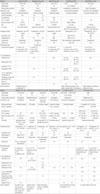1. The Korean Society of Infectious Diseases. The Korean Society for Chemotherapy. Korean Association of Urogenital Tract Infection and Inflammation. The Korean Society of Clinical Microbiology. Clinical guideline for the diagnosis and treatment of urinary tract infections: asymptomatic bacteriuria, uncomplicated & complicated urinary tract infections, bacterial prostatitis. Infect Chemother. 2011. 43:1–25.

2. Raz R, Chazan B, Kennes Y, Colodner R, Rottensterich E, Dan M, Lavi I, Stamm W. Israeli Urinary Tract Infection Group. Empiric use of trimethoprim-sulfamethoxazole (TMP-SMX) in the treatment of women with uncomplicated urinary tract infections, in a geographical area with a high prevalence of TMP-SMX-resistant uropathogens. Clin Infect Dis. 2002. 34:1165–1169.
3. Warren JW, Abrutyn E, Hebel JR, Johnson JR, Schaeffer AJ, Stamm WE. Guidelines for antimicrobial treatment of uncomplicated acute bacterial cystitis and acute pyelonephritis in women. Infectious Diseases Society of America (IDSA). Clin Infect Dis. 1999. 29:745–758.
4. Tollman SM, Bastian H, Doll R, Hirsch LJ, Guess HA. What are the effects of the fifth revision of the Declaration of Helsinki? BMJ. 2001. 323:1417–1423.

5. Ferry SA, Holm SE, Stenlund H, Lundholm R, Monsen TJ. The natural course of uncomplicated lower urinary tract infection in women illustrated by a randomized placebo controlled study. Scand J Infect Dis. 2004. 36:296–301.

6. Gupta K, Hooton TM, Naber KG, Wullt B, Colgan R, Miller LG, Moran GJ, Nicolle LE, Raz R, Schaeffer AJ, Soper DE. Infectious Diseases Society of America. European Society for Microbiology and Infectious Diseases. International clinical practice guidelines for the treatment of acute uncomplicated cystitis and pyelonephritis in women: A 2010 update by the Infectious Diseases Society of America and the European Society for Microbiology and Infectious Diseases. Clin Infect Dis. 2011. 52:e103–e120.

7. Paterson DL. "Collateral damage" from cephalosporin or quinolone antibiotic therapy. Clin Infect Dis. 2004. 38:Suppl 4. S341–S345.

8. Lee KS, Chang KH, Kim YK, Kim MS, Choi JY, Kim CO, Huh AJ, Yeom JS, Chung DR, Chung JW, Woo JH, Kim JM. Clinical study for the efficacy and safety of piperacillin/sulbactam (Combicin ®) in the treatment of urinary tract infection (Phase III). Korean J Infect Dis. 2002. 34:235–241.

9. Wie SH, Choi SM, Lee DG, Kim SY, Kim SI, Yoo JH, Shin WS, Kang MW. Antibiotic sensitivity of the causative organisms and use of antibiotics in women with community-acquired acute pyelonephritis. Korean J Infect Dis. 2002. 34:353–359.

10. Wie SH, Chang UI, Kim HW, Kim YS, Kim SY, Hur J, Kim SI, Kim YR, Kang MW. Clinical features and antimicrobial resistance among clinical isolates of women with community-acquired acute pyelonephritis in 2001-2006. Infect Chemother. 2007. 39:9–16.

11. Ryu KH, Kim MK, Jeong YB. A recent study on the antimicrobial sensitivity of the organisms that cause urinary tract infection. Korean J Urol. 2007. 48:638–645.

12. Lee SJ, Lee SD, Cho IR, Sim BS, Lee JG, Kim CS, Kim ME, Cho YH, Woo YN. Antimicrobial susceptibility of uropathogens causing acute uncomplicated cystitis in female outpatients in South Korea: a multicentre study in 2002. Int J Antimicrob Agents. 2004. 24:Suppl 1. S61–S64.

13. Kim ME, Ha US, Cho YH. Prevalence of antimicrobial resistance among uropathogens causing acute uncomplicated cystitis in female outpatients in South Korea: a multicentre study in 2006. Int J Antimicrob Agents. 2008. 31:Suppl 1. S15–S18.

14. Sohn DW, Ha US, Seo HJ, Lee JY, Kim SW, Cho YH.
In vitro susceptibility study of oral antibiotics to
Escherichia coli, isolated from acute uncomplicated cystitis in female outpatients. Infect Chemother. 2006. 38:140–145.

15. Pai HJ. Is it acceptable to select antibiotics for the treatment of community-acquired acute cystitis based on the antibiotics susceptibility results for uropathogens from community-acquired acute pyelonephritis in Korea? Infect Chemother. 2012. 44:269–274.

16. Czaja CA, Scholes D, Hooton TM, Stamm WE. Population-based epidemiologic analysis of acute pyelonephritis. Clin Infect Dis. 2007. 45:273–280.

17. Scholes D, Hooton TM, Roberts PL, Gupta K, Stapleton AE, Stamm WE. Risk factors associated with acute pyelonephritis in healthy women. Ann Intern Med. 2005. 142:20–27.

18. Jeon JH, Kim K, Han WD, Song SH, Park KU, Rhee JE, Song KH, Park WB, Kim ES, Park SW, Kim NJ, Oh MD, Kim HB. Empirical use of ciprofloxacin for acute uncomplicated pyelonephritis caused by
Escherichia coli in communities where the prevalence of fluoroquinolone resistance is high. Antimicrob Agents Chemother. 2012. 56:3043–3046.

19. Lim SK, Park IW, Lee WG, Kim HK, Choi YH. Change of antimicrobial susceptibility among
Escherichia coli strains isolated from female patients with community-onset acute pyelonephritis. Yonsei Med J. 2012. 53:164–171.

20. Pépin J, Saheb N, Coulombe MA, Alary ME, Corriveau MP, Authier S, Leblanc M, Rivard G, Bettez M, Primeau V, Nguyen M, Jacob CE, Lanthier L. Emergence of fluoroquinolones as the predominant risk factor for Clostridium difficile-associated diarrhea: a cohort study during an epidemic in Quebec. Clin Infect Dis. 2005. 41:1254–1260.

21. Pai H. Current epidemiology and treatment of
Clostridium difficile infection. Infect Chemother. 2010. 42:362–368.

22. Weiss K. Poor infection control, not fluoroquinolones, likely to be primary cause of Clostridium difficile-associated diarrhea outbreaks in Quebec. Clin Infect Dis. 2006. 42:725–727. author reply 727-9.

23. Vila J, Simon K, Ruiz J, Horcajada JP, Velasco M, Barranco M, Moreno A, Mensa J. Are quinolone-resistant uropathogenic
Escherichia coli less virulent? J Infect Dis. 2002. 186:1039–1042.

24. Kim KY, Kim CS, Lim DH. The ciprofloxacin resistance pattern of Escherichia coli isolated from female patients with community-acquired urinary tract infection in the Jeonnam and Gwangju region for the recent 2-years. Korean J Urol. 2008. 49:540–548.
25. Hwang BY, Lee JG, Park DW, Lee YJ, Kim SB, Eom JS, Sohn JW, Cheong HJ, Kim WJ, Kim MJ, Park SC. Antimicrobial susceptibility of causative microorganisms in adults with acute pyelonephritis at one university-affiliated hospital in Southwestern Seoul. Infect Chemother. 2003. 35:277–282.





 PDF
PDF ePub
ePub Citation
Citation Print
Print



 XML Download
XML Download